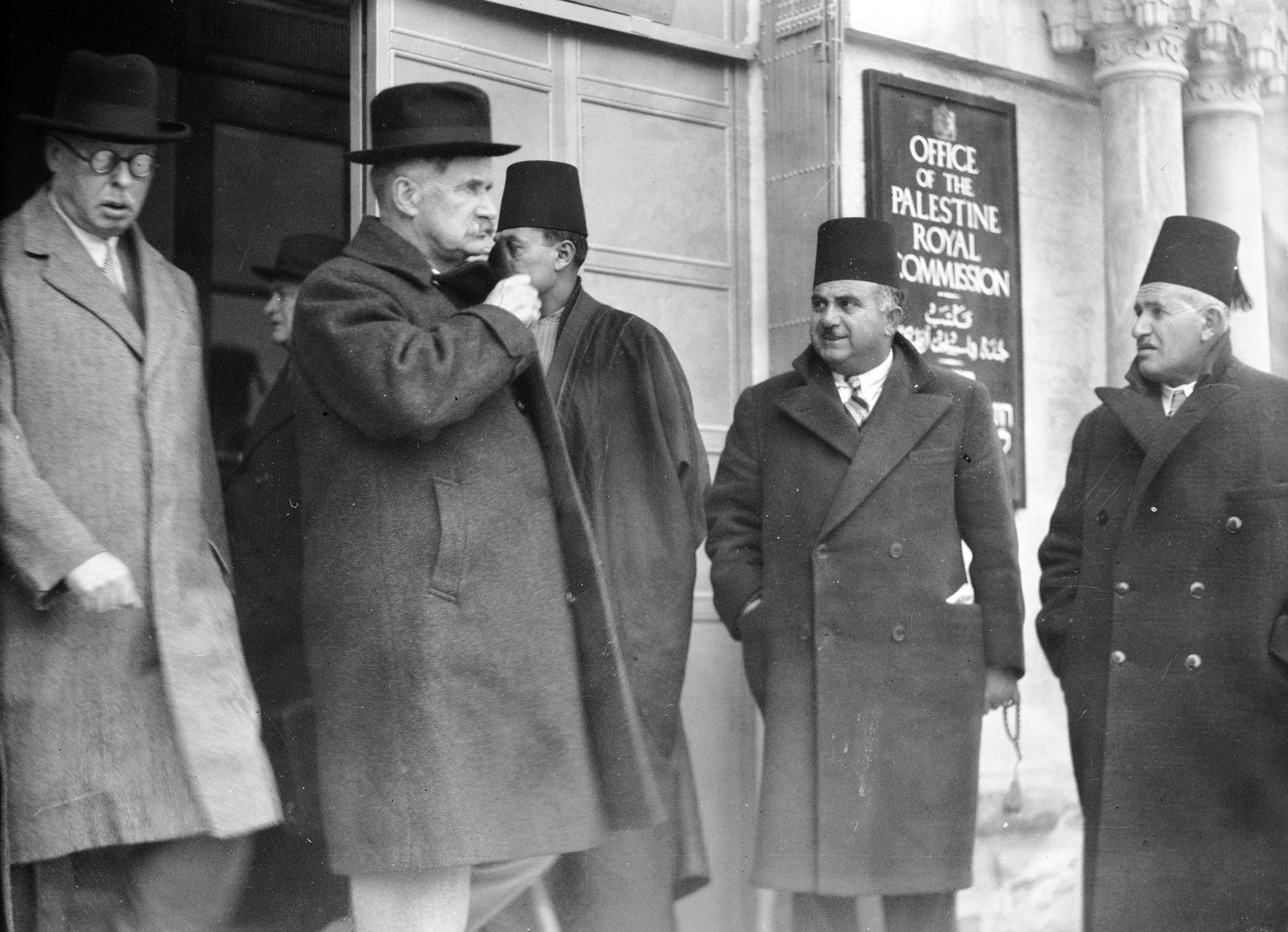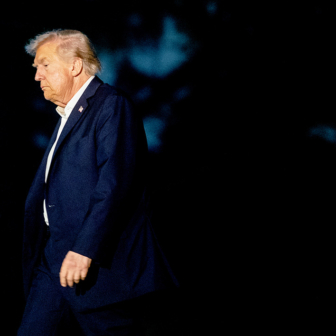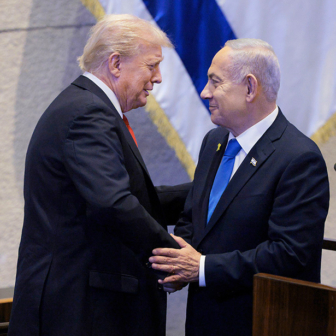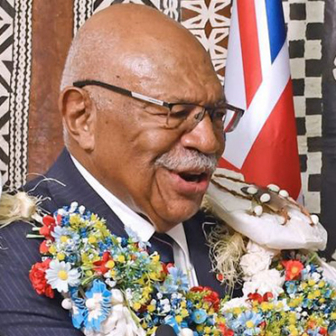History casts a shadow over the Middle East at the best of times, and none more so than now.
Take the phrase “two-state solution,” which has become the political currency of the moment. Few, if any, longer historical shadows have fallen across the Middle East than this reference to an ideal of two countries, one Israeli and the other Palestinian, living side by side in relative harmony.
In the absence of a realistic pathway towards resolving the longest-running conflict in modern history, this hollowed-out phrase serves an obvious political purpose.
I use the word “pathway” deliberately. This was the terminology chosen by foreign minister Penny Wong last week when she outlined Labor’s approach to resolving the Israel–Palestine conflict. “We need to build a pathway to a peace that is enduring and just,” she told the ANU’s National Security College in a landmark speech. “Because the simple truth is that a secure and prosperous future for both Israelis and Palestinians will only come with a two-state solution.”
Wong went on to canvass the possibility that Australia might accord recognition to a Palestinian state as a “pathway” towards a revitalised peace process. Controversially, recognition would take place ahead of final-status negotiations on all the vexed issues that have stymied a peace process over many years.
Leaving aside the wisdom of this approach, her remarks were aligned with views expressed by the leaders of several of Australia’s close allies, including, principally, Britain. Conservative foreign secretary David Cameron had suggested a similar step a few weeks earlier, on the basis that whatever had been tried before was not working.
Wong’s alignment with Cameron produced a reaction in Australian domestic politics that was as discordant as it was ill-judged. Opposition leader Peter Dutton indulged in the sort of hyperbole that defines his leadership, declaring it “the most reckless act of a foreign minister I have seen in my twenty-two years in the parliament.”
His remarks were echoed by conservative media, which has adopted an Israel-right-or-wrong culture-wars approach to the Israel–Palestine issue. So invested have sections of the media become in this point of view that headlines appear regularly in which Wong is “lashed” by spokespersons for an assortment of Jewish organisations — including the Executive Council of Australian Jewry, the Zionist Federation of Australia and the Australia Israel Jewish Affairs Council — all espousing very similar viewpoints.
I’ll leave it to the reader to judge whether the views of particular lobby groups who are in the habit of “lashing Wong” are given more credence than is justified.
Wong’s act of “recklessness” was, of course, not reckless at all. It may have been naive, given an unpromising situation on the ground; it may have been contrived, given the complexities of the issue; it may have aimed to ease political pressures in Labor’s heartland seats. But reckless? Hardly.
For argument’s sake, and without much hope of genuine progress towards illusion becoming reality, let us consider prospects for a “two-state solution” in light of the terrible conflict in Gaza.
First, it might be useful to trace the evolution of the concept from the 1917 declaration by British prime minister Arthur Balfour, in which he pledged support for a national home for Jewish people in Palestine, up to the present. Like rusting tanks left in the desert after one of the Middle East’s innumerable wars, the signposts have found themselves submerged in shifting sands of subterfuge, mendacity and ill will.
From Balfour to the 1937 Peel Commission, which first proposed separate Jewish and Arab states; to the United Nations “partition plan” of the 1947; to the wars of 1967 and 1973 that redrew the maps of Israel and Palestine; to the Camp David Accords of 1978 that ushered in a cold peace between Israel and Egypt; to the still-born Oslo peace process of 1993; to subsequent attempts to achieve an historic compromise — all have added layers of complexity.
This was certainly the case at Camp David in 1999 and at Taba in 2000, when a last-minute effort by US president Bill Clinton’s administration to bring Israelis and Palestinians together foundered in a sea of mistrust, with much of the blame for this failure accruing to the Palestinians. Desultory attempts were made during George W. Bush’s administration, and a more purposeful effort was launched by Barack Obama to bring the parties together, but such efforts trickled into the sand.
Donald Trump advanced his own solution by proclaiming that he was intent on bringing off what he called the “deal of the century.” As far as the Palestinians were concerned this was no deal at all, rather than an attempt to expunge their legitimate rights to a sovereign state undiluted by increasing numbers of Jewish settlers. In truth, Trump’s deal was a confidence trick detrimental to Palestinian interests, as if anyone should have been surprised.
Along the way, and apart from the Oslo process and the Clinton initiative, other significant two-state proposals have included the Arab Peace Initiative of 2002, also known as the Saudi Initiative, which laid down terms for a resolution of the Israel–Palestine conflict. Broadly, it called for Israel’s withdrawal from territories occupied in the 1967 war and the creation of a Palestinian state with East Jerusalem as its capital.
The chances of Israel agreeing to this formulation are, to say the least, remote. But the formula, agreed at an Arab League summit in Beirut and reaffirmed in 2007, remains the cornerstone of Arab demands.
Since no resolution of the Palestine issue remains remotely possible without a regional consensus, the Saudi initiative can’t be disregarded, however far-fetched its demands may seem in light of current circumstances. Separate from efforts to embed a two-state solution into Middle East peacemaking, a binational state in which Jews and Arabs co-exist has its advocates. However, the likelihood of such a “one-state solution” gaining traction is negligible given that Jewish people would risk ceasing to be a majority in a combined state.
History hangs heavy on the Middle East and nowhere more so than in a conflict whose contours are now further complicated by threats of a regional war between Israel and Iran. Israel’s colonisation of swathes of the West Bank, and the subjugation of a resident population to stifling military rule, remains the greatest single impediment to a settlement of the Israel–Palestine conflict based on a two-state solution. Put simply: how do you unscramble the egg?
Again, history is important.
The phrase “two-state solution” didn’t gain traction in peace-making efforts until Jordan’s King Hussein relinquished his claim to represent the Palestinians of the West Bank and East Jerusalem in 1985. The role had been assumed by the Hashemite monarchy in 1950, not long after Israel’s 1947–48 war of independence, when Jordan annexed the West Bank and East Jerusalem.
The king’s reluctant acceptance of reality enabled an animated discussion about two states, one that Palestinian leader Yasser Arafat was able to exploit. This important historical moment is dealt with in my book Arafat: The Biography.
By 1985, the Palestine Liberation Organisation under Arafat had long abandoned the illusion of armed victory over Israel. After King Hussein’s intervention that year the PLO moved hesitantly towards endorsing Israel’s right to exist under a two-state formula. At a press conference on the sidelines of the 1988 UN General Assembly, Arafat reluctantly accepted Israel’s right to exist, de facto and de jure, by endorsing UN Security Resolution 242, which implicitly recognised Israel. He also renounced terrorism as a means for the PLO to achieve its objectives.
This was the PLO’s down payment on a “two-state solution,” and one that embedded the phrase in Middle East peace-making.
That was thirty-six years ago. Apart from an all-too brief moment between 1993–95, following the signing of the Oslo Peace Accords, and the Clinton initiative of 1999–2000, a two-state solution has remained elusive, and never more so than now.
The current conflict will not retire the phrase, of course, since politicians need to be seen to be making constructive suggestions, even if they have no intention of doing anything about them.
Foreign minister Wong should not be censured unduly for this: at least she was suggesting an alternative “pathway” in an effort break the mould of a tired debate in which “final status” discussions have served as a barrier to progress. Her critics offered not much beyond restatements of an allegiance to Israel under an extremist nationalist leadership whose impulses are to crush Palestinian aspirations.
Benjamin Netanyahu’s response to those who have sought to create “pathways” to peace has been to pursue an aggressive annexationist policy in the Occupied Territories built on ever-expanding settlements.
In all of this it is hard to disagree with Rashid Khalidi, the Edward Said professor of modern Arab studies at Columbia University. In an essay for the Guardian last week, “A New Abyss: Gaza and the Hundred Years War on Palestine,” he derides the lip service paid to a two-state solution by the Biden administration.
“There was no sign,” he writes, “that the US would demand implementation of the essential prerequisites for such a solution: a rapid and complete end to Israel’s nearly fifty-seven-year military occupation and to its usurpation and colonisation of Palestinian land, which has planted nearly 750,000 illegal settlers in 60 per cent of the West Bank and East Jerusalem.”
With no indication these measures would be firmly enforced, says Khalidi, “a call for a ‘two-state solution’ has always been meaningless, a cruel Orwellian hoax.” •




